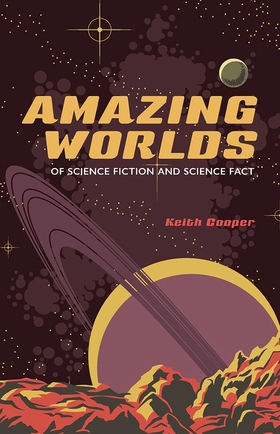Centauri Dreams
Imagining and Planning Interstellar Exploration
PLATO: Planet Hunting Mission Officially Adopted
The European Space Agency has just announced the official adoption of the PLATO mission. The untangled acronym — PLAnetary Transits and Oscillations of stars — tells us that, like Kepler and CoRoT, this is a planet hunting mission with asteroseismological implications. Photometric monitoring of nearby bright stars for planetary transits and determination of planetary radii should help build our target list for spectroscopic follow-up as we delve into planetary atmospheres looking for biosignatures. Launch is scheduled for 2026.
Asteroseismology studies how stars oscillate, giving us information about the internal structure of the star that would not be available through properties like brightness and surface temperature. PLATO will be carrying out high precision photometric monitoring at visible wavelengths, targeting bright stars (mV ? 11), though with capabilities for fainter stars down to magnitude 16. Several hundred thousand stars will ultimately be characterized in the search for planets around G-class stars like the Sun, subgiants and red dwarf stars.
Keep in mind one important difference between PLATO and Kepler. The latter worked with a starfield that was in most cases quite faint, down to magnitude 17. No one can argue with the success of Kepler and its recently released final catalog, but the faintness of many of its stars meant that many planetary candidates have proven difficult to follow up and confirm. PLATO’s wide field will allow monitoring of the brightest stars, which should allow smaller planets to be followed up by ground-based instruments and ultimately confirmed.
“Using observations of stellar vibrations, PLATO will for the first time fully characterize these stars and their planets with regard to mass, radius, and age”, says Prof. Dr. Laurent Gizon, director of the Max Planck Institute for Solar System Research and head of the PLATO Data Center. “This will revolutionize the study of the evolution of exoplanets and their host stars… With today’s adoption, the implementation – the actual building and construction of the spacecraft and its instruments – can begin. In parallel, the design of the software to analyse the observations will be developed at the PLATO Data Center.”
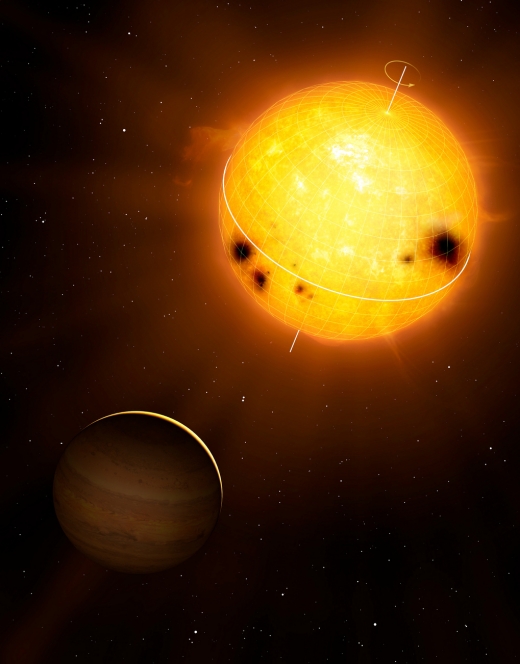
Image: Artist’s impression of one of the new worlds that PLATO will discover. Among those there will be Earth-like planets around Sun-like stars with the potential to host life. Credit & copyright: MPS/ Mark A. Garlick (markgarlick.com).
Bear in mind, too, that unlike the upcoming TESS (Transiting Exoplanet Survey Satellite) mission, PLATO will have the ability not only to do asteroseismology (quite useful in determining the size of exoplanets it discovers), but also to look for Earth-like planets around stars like our G-class Sun. TESS should give us plentiful information about planets around M-dwarfs, but PLATO backs us out to Earth-like worlds around stars like our own.
Using 34 separate small telescopes and cameras, PLATO’s current plan calls for a four-year observation period consisting of long-duration observations of two sky fields lasting two years each. But this could change: ESA also charts an alternative course including a single, three-year long-duration phase and a one year phase with several different pointings. The final strategy is not to be decided until two years before launch, but depending on the choice, the mission will cover between 10 percent and 50 percent of the sky during the nominal mission. An extended mission of up to four years will be a built-in option.
Orbiting the L2 Lagrangian point, PLATO should be able to characterize numerous rocky, icy or giant planets at unprecedented levels of precision, with radius measurements down to 3 percent and mass determinations better than 10 percent precision, assembling a catalog of confirmed and characterized planets with known mean densities, compositions and evolutionary stages, some of them being, it is assumed, planets in the habitable zone.
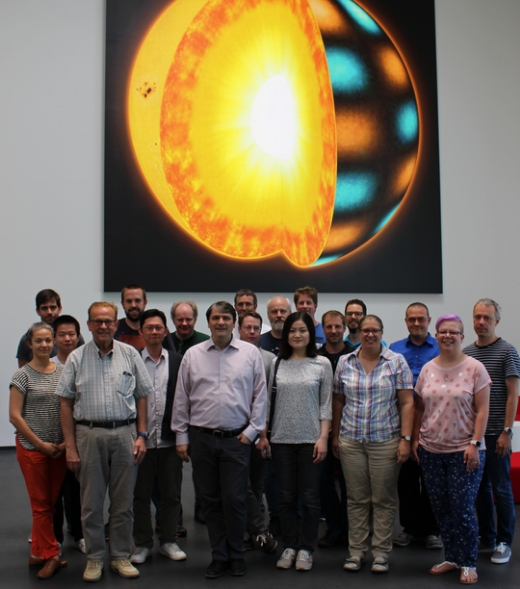
Image: The PLATO-team at the Max Planck Institute for Solar System Research. Credit & copyright: MPS.
ESA’s point about planetary evolution is telling, especially in light of the work we looked at yesterday on mini-Neptunes and the ‘gap’ between them in Kepler data and smaller, rocky worlds. The focus on highly accurate radius and mass measurements and better determination of stellar ages is designed to give us a better understanding of planetary changes over time.
Terrestrial planets can lose their primordial hydrogen atmospheres, later developing secondary atmospheres and perhaps life. A key goal for PLATO, then, is to study the physical and dynamical processes on Earth-like planets at different epochs in the life of a stellar system, with asteroseismology being a key determinant of host star ages. ESA believes asteroseismology can now determine a star’s age to a precision of 10 percent.
And, of course, we continue the quest for planets in the habitable zone of their star. PLATO’s long-duration observations of a star field should allow the mission to capture two transits of any Earth twin it finds around a G-class star. “With this concept and the high precision of the instrument we will find rocky planets orbiting sunlike stars and will be able to characterise them accurately.” says Heike Rauer (DLR-Berlin), principal Investigator of the mission.

A New Classification Scheme for Kepler Planets
As announced yesterday at NASA Ames, the Kepler team has released the final Kepler catalog from the spacecraft’s first four years of data and its deep stare into Cygnus. The numbers still impress me despite our having watched them grow with each new report: We have 4034 planet candidates, of which 2335 have been verified as exoplanets. More than 30 of the approximately 50 near-Earth sized habitable zone candidates have been verified.
The new release brought us 219 new candidates, 10 of them habitable zone possibilities, giving us a final catalog that is our first take on the prevalence and characteristics of planets in the Milky Way, and paving the way for future space-based instruments as we look for targets for atmospheric characterization and direct imaging. By introducing simulated planet transit signals and adding known false signals, the researchers were able to tighten up the catalog, ensuring against errors in the analysis growing out of the team’s processing methods.
The Kepler data are also the subject of a new take on planetary demographics, as seen in the image below, which takes us into the realm of the kind of planets we do not see in our Solar System, so-called ‘mini-Neptunes’ ranging from 2 to 3.5 times the size of Earth.
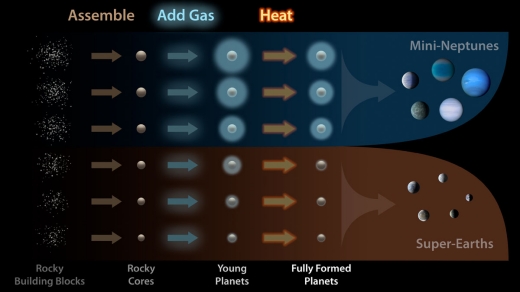
Image: This diagram illustrates how planets are assembled and sorted into two distinct size classes. First, the rocky cores of planets are formed from smaller pieces. Then, the gravity of the planets attracts hydrogen and helium gas. Finally, the planets are “baked” by the starlight and lose some gas. At a certain mass threshold, planets retain the gas and become gaseous mini-Neptunes; below this threshold, the planets lose all their gas, becoming rocky super-Earths. Credit: NASA/Kepler/Caltech (R. Hurt).
A research group working under Andrew Howard (Caltech) has drilled deep into the dataset, measuring the size of 1300 stars in the Kepler field of view to determine the radii of 2025 Kepler planets with four times more precision than had previously been achieved. Out of this work on planetary sizes comes the finding that these planets can be classified into two distinct groups: Rocky Earth-like planets and mini-Neptunes. From the paper:
We find evidence for a bimodal distribution of small planet sizes. Sub-Neptunes and super-Earths appear to be two distinct planet classes. Planets tend to prefer radii of either ?1.3 R? or ?2.4 R?, with relatively few planets having radii of 1.5–2.0 R?. Planets in the gap have the maximum size for a rocky core, as seen in previous studies of bulk planet density and of ultra-short period planets. We posit that the bimodal planet radius distribution stems from differences in the envelope masses of small planets. While our current dataset is insufficient to distinguish between theoretical models that produce the gap, it charts a path forward to unraveling further details of the properties of the galaxy’s most abundant planets.
Although most of the Kepler planets have proven to be between the size of the Earth and Neptune, the planets were previously thought to span the range between the two rather than to fall into distinct groupings. Erik Petigura (Caltech) is a co-author of the new study, which will appear in The Astronomical Journal, along with two other papers that make up an observational program known as the California-Kepler Survey (see citations below):
“In the solar system, there are no planets with sizes between Earth and Neptune. One of the great surprises from Kepler is that nearly every star has at least one planet larger than Earth but smaller than Neptune. We’d really like to know what these mysterious planets are like and why we don’t have them in our own solar system.”
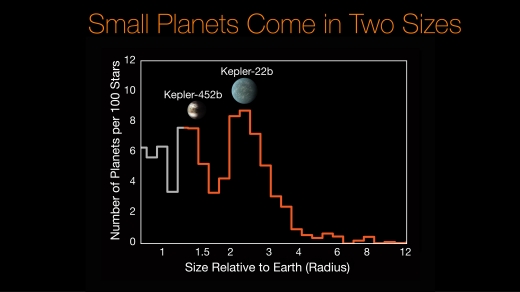
Image: Researchers using data from the W. M. Keck Observatory and NASA’s Kepler mission have discovered a gap in the distribution of planet sizes, indicating that most planets discovered by Kepler so far fall into two distinct size classes: the rocky Earths and super-Earths (similar to Kepler-452b), and the mini-Neptunes (similar to Kepler-22b). This histogram shows the number of planets per 100 stars as a function of planet size relative to Earth. Credit: NASA/Ames/Caltech/University of Hawaii (B. J. Fulton).
The Keck work involved researchers at UC Berkeley, Harvard, the University of Hawaii, Princeton and the University of Montreal as well as Caltech, a multi-year project analyzing the Kepler spectral data to obtain precise measurements of the host stars, which then allowed the scientists to refine the sizes of the planets orbiting those stars. Why the planets exist in two distinct groups — with a clear gap between rocky Earths and mini-Neptunes — remains problematic. Are Earth-sized planets the norm, with some of them simply obtaining enough of a gas envelope to become mini-Neptunes? Andrew Howard comments:
“A little bit of hydrogen and helium gas goes a very long way. So, if a planet acquires only 1 percent of hydrogen and helium in mass, that’s enough to jump the gap. These planets are like rocks with big balloons of gas around them. The hydrogen and helium that’s in the balloon doesn’t really contribute to the mass of the system as a whole, but it contributes to the volume in a tremendous way, making the planets a lot bigger in size.”
On the other hand, the researchers speculate, it may be that planets without enough of a gas envelope to fall into the gap can lose gas because of radiation from the host star. In this scenario, planets that wind up in the gap aren’t likely to stay there for long, producing thin atmospheres that are quickly blown off. Either scenario produces the populations we see in the new data, but we’ll need to learn more about the composition of mini-Neptunes to get a picture of why they seem to form so easily around other stars but not around our Sun.
The paper adds this:
…making a planet with a thin atmosphere requires a finely tuned amount of H/He. Second, photoevaporating a planet’s envelope significantly changes its size. Our observation of two peaks in the planet size distribution is consistent with super-Earths being rocky planets with atmospheres that contribute negligibly to their size, while sub-Neptunes are planets that retain envelopes with mass fractions of a few percent.
Three papers from the California-Kepler Survey are now available on the arXiv site in preprint form, all of them accepted for publication at The Astronomical Journal: Petigura et al., “The California-Kepler Survey. I. High Resolution Spectroscopy of 1305 Stars Hosting Kepler Transiting Planets” (preprint); Johnson et al., “The California-Kepler Survey. II. Precise Physical Properties of 2025 Kepler Planets and Their Host Stars” (preprint); and Fulton et al., “The California-Kepler Survey. III. A Gap in the Radius Distribution of Small Planets” (preprint).

Pale Red Dot: Campaign 2
The Pale Red Dot campaign that discovered Proxima Centauri b produced one of the great results of exoplanet detection. For many of us, the idea that a world of roughly Earth mass might be orbiting in Proxima Centauri’s habitable zone — where liquid water can exist on the surface — was almost too good to be true, and it highlighted the real prospect that if we find such a planet around the closest star to our own, there must be many more around similar stars. Hence the importance of learning more about our closest neighbors.
Which is why it’s so heartening to see that Pale Red Dot is by no means done. This morning, the team led by Guillem Anglada-Escudé (Queen Mary University, London) announced plans to acquire data from the European Southern Observatory’s HARPS instrument (High Accuracy Radial velocity Planet Searcher) in a new campaign to study not just Proxima Centauri in search of further planets, but also the red dwarfs Barnard’s Star and Ross 154.

Also involved will be a network of small telescopes performing photometric monitoring, including the Las Cumbres Global Observatory Telescope network, SpaceObs ASH2 in Chile, the Observatorio de Sierra Nevada and the Observatorio Astronómico del Montsec, both in Spain. But the star of the show continues to be HARPS, a high-precision spectrograph attached to the ESO’s 3.6-meter telescope at La Silla. HARPS is capable of detecting radial velocity motions down to 3.5 kilometers per hour, the pace of a leisurely evening walk.
Image: Lead author Guillem Anglada-Escudé speaking at a press conference in Garching, Germany about the 2016 discovery of Proxima Centauri b. Credit: ESO/M. Zamani.
Are there other planets around Proxima Centauri? The findings around TRAPPIST-1, all seven of them, give reason to hope that we’ll make further discoveries. As to Barnard’s Star, we still have no information about planets there, although for a time in the mid-20th Century, it was thought due to instrument error that there might be one or more gas giants orbiting the star. We know now that that isn’t the case, but the possibility of terrestrial-class worlds remains.
I’ll have more to say about that situation later in the week, but do want to note that the reason the Project Daedalus planners chose Barnard’s Star as their mission target was the supposition that those planets existed. Proxima Centauri would obviously have been a closer target.
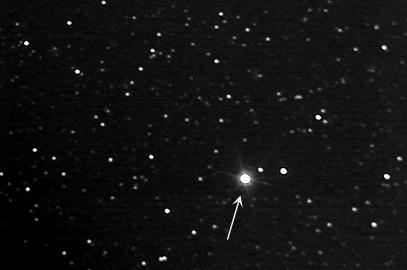
Image: Barnard’s Star ca. 2006. Credit: Steve Quirk.
The M-dwarf Ross 154 is just under 10 light years from Earth, the nearest star in Sagittarius. That distance is closing at a good clip (in astronomical terms), so that the star will come to within about 6.4 light years in another 157,000 years. Like Proxima Centauri, Ross 154 is a UV Ceti-type flare star, producing major flares on the order of every two days. Given that flare activity in M-dwarfs is a major factor in the question of whether life can develop, finding planets close enough to be characterized by later space and ground telescopes would be a significant development, and the more systems the better to allow comparative analysis.
It will be fascinating to watch the new Pale Red Dot campaign develop, for these observations will be highly visible to the general public. While Pale Red Dot presented its results on Proxima b to the public only after extensive peer review, the observational data from the new campaign, beginning with Proxima Centauri, will be revealed and discussed in real time.
#ESOCastLight on #RedDots — the hunt for the nearest exoplanets #BiteSizedAstronomy #4K #UHD https://t.co/X1aFyJSHFO pic.twitter.com/9PU1f8TqSD
— ESO (@ESO) June 19, 2017
The scientists involved intend to maintain an active social media presence supported by various online tools. Keep an eye on the Red Dots Facebook page, the Red Dots Twitter account and the #reddots hashtag, as well as the main project page, where updates and featured contributions from the community will be posted on a regular basis.

A Fusion Runway to Deep Space?
Beamed propulsion concepts are usually conceived in terms of laser or microwave beams pushing a lightsail. But as we’ve seen over the years, there are other ways of thinking about these things. Clifford Singer went to work back in the 1970s on the concept of pellet streams fired by an accelerator, each pellet a few grams in size. The idea here is to vaporize the pellets when they reach the spacecraft, their energy being redirected as a plasma exhaust.
There are enough interesting variations on the idea that I’ll probably return to it soon. But over the weekend, an email from Jeff Greason reminded me of Jordin Kare’s unusual ‘fusion runway’ idea, to which he attached the moniker the ‘Bussard Buzz Bomb.’ Kare is an astrophysicist and space systems consultant with a background in laser technologies. He’s been involved in studies of laser launch methods, in which beamed energy is focused on an onboard heat exchanger that converts liquid propellant into a gas to produce thrust. Currently he serves as chief scientist for LaserMotive, a laser power transmission firm in Kent, WA.

Image: Astrophysicist and space systems consultant Jordin Kare.
In the interstellar community, Kare is best known for SailBeam, where pellet propulsion is supplanted by tiny micro-sails that are pushed at huge velocities to the spacecraft, to be vaporized there much in the manner of Singer’s pellets. His sails turn out to require a smaller optical system than would be needed to push a large sail, and they can be driven to high accelerations while still close to the beam, reducing pointing and collimation challenges.
But I haven’t said much in these pages about Kare’s fusion runway, which he presented at a Workshop on Advanced Space Propulsion at the Jet Propulsion Laboratory back in the late 1990s. In 2003, when I interviewed him for my Centauri Dreams book, Kare gave me a breakdown of the concept. The idea harkens back to pellets, in this case fusion fuel pellets made up of deuterium and tritium that are slammed together to achieve ignition.
The pellets are laid down in an outbound track for the spacecraft that will eventually use them, deployed in advance by small spacecraft seeding the runway along the route of flight. Kare thinks in terms of a runway about half a light-day in length. The accelerating spacecraft would gobble up the fusion pellets one at a time, taking about ten days to exit the Solar System, moving along a runway track that stretched from near Earth to beyond the orbit of Pluto.
What kind of a craft would this be? Think in terms of a vehicle in the shape of a doughnut, or perhaps in more elongated form as a cylinder. The spacecraft would have its own supply of fusion fuel pellets. As the craft accelerates, it drops a pellet into the central ‘hole’ when one of the pellets of the fusion runway is about to be encountered. Nearing the end of the fusion runway, the spacecraft is being driven by fusion explosions at the rate of thirty per second.
The fusion runway relies on impact fusion, with the departing spacecraft first needing to reach speeds high enough (about 200 kilometers per second, by Kare’s reckoning) to ignite the reaction. Once ignition is achieved, the craft continues to accelerate along the runway track. The runway length would have to be adjusted depending on the mission, with robotic probes obviously capable of coping with far higher accelerations than humans. Add a human crew at 1 g of acceleration and a fusion runway might need to stretch out to a tenth of a light year.
String enough fuel pellets along the runway and the spacecraft gets up to ten percent of c. Although Kare built his workshop presentation around a one-ton interstellar probe, he sees the concept as scalable, telling me in that interview: “The fusion runway doesn’t care if you’re working with a ten or a hundred ton probe. You just need more pellets. You don’t need to build larger lasers. So it probably scales up better than most other schemes.”
Several other advantages emerge in the fusion runway concept. So-called ‘impact fusion’ doesn’t require the exquisitely symmetrical fuel pellets demanded by inertial confinement methods, nor does it demand that each pellet be fed energy simultaneously from every direction. Remember that Kare is assuming a spacecraft that is already moving — through some other energy source — at 200 kilometers per second to achieve ignition. From that point on, velocity depends upon the number of fuel pellets available in the runway ahead.
When I think about possible show-stoppers here, I wonder about accuracy. After all, each runway pellet has to hit the ship-borne pellet precisely, though Kare believes that this could be managed by laser pulses guiding the pellets internally. Perhaps the ship can be designed so as to channel runway pellets to the exact point of collision. Also challenging is the magnetic nozzle that will be necessary to contain the fusion explosions and direct their energy.
As far as getting up to speed, Geoff Landis told me some years back that a close pass by the surface of the Sun could be used to reach somewhere in the range of 500-600 kilometers per second. That could give you the velocity needed for ignition. Line the fuel pellets up so as to begin hitting them outbound and the method could work. In our recent email exchange, Landis does question Kare’s 200 kilometers per second as the sufficient velocity to ignite impact fusion — some figures in the literature point to 3500 km/s for a deuterium/tritium mixture.

Image: Not exactly an interstellar prototype, but the German V1 gives its name to an advanced propulsion concept because of how it would sound (if you could hear it). Credit: Bundesarchiv, Bild 146-1975-117-26 / Lysiak / CC-BY-SA 3.0.
The ‘buzz bomb’ reference? That one is easy. The German V-1 was a pulse-jet rocket that gave off a characteristic staccato buzzing sound much like what a fusion runway spacecraft would sound like if you could hear it at all. The nod to Robert Bussard stems from the latter’s work on interstellar ramjet concepts, craft that pull in interstellar hydrogen to serve as fuel. Thus we have, as so often in interstellar studies, a hybrid design putting two distinct propulsion concepts together in ways that attempt to enhance the performance of each.

Do All Stars Form as Binaries?
Interesting news this morning that begins with the Very Large Array in New Mexico, which a team of astronomers has been using to look at star formation. Their target: The Perseus molecular cloud, a stellar nursery about 600 light years from Earth. Clouds like this are sufficiently large (this one is about 50 light years in length) and dense to permit molecules to form, with molecular hydrogen (H2) being the most common, along with carbon monoxide (CO).

Although we can’t see into them in visible light (they appear as holes in the starry background because dust and gas obscure the stars forming inside, as well as background stars), such molecular clouds are ideally suited for study with radio telescopes. The VLA survey, called VANDAM (VLA Nascent Disk and Multiplicity) surveyed all the young stars in the Perseus cloud, including both single and multiple stars at separations down to < 20 AU. And now a duo of astronomers has supplemented the VLA data with observations from the James Clerk Maxwell Telescope in Hawaii, the latter helping to reveal the clumps of higher density called ‘dense cores’ — think of them as egg-shaped ‘cocoons’ — within which young stars form.
Image: Radio image of a very young binary star system, less than about 1 million years old, that formed within a dense core (oval outline) in the Perseus molecular cloud. According to the new paper, all stars likely form as binaries within dense cores. Credit: SCUBA-2 survey image by Sarah Sadavoy, CfA.
Sarah Sadavoy (Max-Planck-Institut für Astronomie) and Steven Stahler (UC-Berkeley) found 55 young stars in 24 multiple star systems (all but five of these are binary) and 45 single star systems in the Perseus cloud. All the widely separated binaries (> 500 AU) were made up of Class 0 stars (less than 500,000 years old), and were aligned with the long axis of the dense core. The older Class I binary stars (between 500,000 and 1 million years old) were closer together (separations ~ 200 AU) and showed no such alignment.
These alignments may not be random. For the authors have produced a mathematical model that explains the observations, and it’s a model with a twist. What they deduce is that stars like the Sun — all of them — are born with a companion. Says Stahler:
“We ran a series of statistical models to see if we could account for the relative populations of young single stars and binaries of all separations in the Perseus molecular cloud, and the only model that could reproduce the data was one in which all stars form initially as wide binaries. These systems then either shrink or break apart within a million years.”
A wide binary as considered here is one with a separation of more than 500 AU, which would mean that the original binary companion to our Sun, assuming it once existed, would have been about 17 times further out than Neptune is today. Nemesis? Only in that this would have been a companion to our star, though not one that, like the conjectured Nemesis once considered as a hypothesis for driving asteroid collisions with the Earth, stayed in our neighborhood.
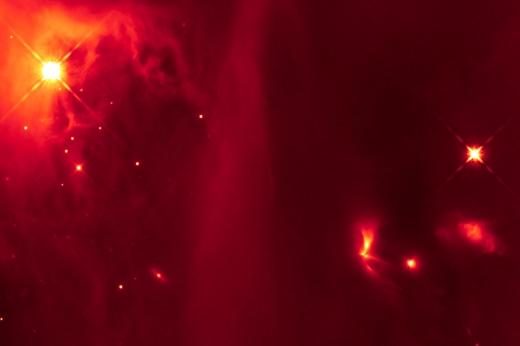
Image: This infrared image from the Hubble Space Telescope contains a bright, fan-shaped object (lower right quadrant) thought to be a binary star that emits light pulses as the two stars interact. The primitive binary system is located in the IC 348 region of the Perseus molecular cloud and was included in the study by the Berkeley/Harvard team. Credit: NASA, ESA and J. Muzerolle, STScI.
In fact, the outcome based on Sadavoy and Stahler’s models is that the Sun’s companion escaped long ago. This would not be an uncommon result, for the early period of star formation would be turbulent. The wide binaries from the early period of star formation either break into separate stars or else shrink into tighter orbits to form tight binaries. Stahler again:
“As the egg contracts, the densest part of the egg will be toward the middle, and that forms two concentrations of density along the middle axis. These centers of higher density at some point collapse in on themselves because of their self-gravity to form Class 0 stars. Within our picture, single low-mass, sunlike stars are not primordial. They are the result of the breakup of binaries.”
An interesting result, and keep this in mind (from the paper): “If our model continues to provide a good fit to other star-forming regions, then the mass fraction of dense cores that becomes stars is double what is currently believed.”
In trying to learn how binary and multiple star systems form, we’ve begun to produce computer simulations examining the behavior of collapsing masses of gas, as well as simulating how young multiple stars behave as they emerge from their gas clouds. What this work addresses is the fact that among the population of young stars, binaries exist in higher proportion. The authors point to the need for higher resolution studies in other star-forming regions to continue the systematic analysis of the role of binaries in early stellar evolution.
The paper is Sadavoy and Stahler, “Embedded Binaries and Their Dense Cores,” accepted at Monthly Notices of the Royal Astronomical Society (preprint). This UC-Berkeley news release is helpful.

Focus on Interstellar Prebiotic Chemistry
400 light years away in a star-forming region called Rho Ophiuchi there is an interesting stellar system in the making. Catalogued as IRAS 16293-2422, what we have here is a triple protostar system — a binary separated by 47 AU and a third star at 750 AU. All three have masses similar to the Sun, and while the system is young, it has already achieved a certain fame in that researchers working with data from the Atacama Large Millimeter Array have been able to identify a simple form of sugar called glycolaldehyde in surrounding gas.
Learning that building blocks of life can form in other systems is useful, but here we have sugar in the region where a protoplanetary disk can form, an indication that such materials are widely available in the places where planets begin to coalesce around their host star.
Then just this month we’ve learned that further ALMA work has yielded the prebiotic organic molecule methyl isocyanate (CH3NCO) in the same system. Niels Ligterink (Leiden Observatory) and Audrey Coutens (University College, London), who led one of two teams on this work, issued this statement pointing to the significance of the find:
“This star system seems to keep on giving! Following the discovery of sugars, we’ve now found methyl isocyanate. This family of organic molecules is involved in the synthesis of peptides and amino acids, which, in the form of proteins, are the biological basis for life as we know it.”
The term ‘complex organic molecules’ in this context refers to molecules consisting of six or more atoms, of which at least one is a carbon atom — such organic molecules are widely observed in regions of star formation. Prebiotics are a subset, a category of complex molecules with interesting implications for life. From the Ligterink paper, one of two scheduled to appear in Monthly Notices of the Royal Astronomical Society:
A special category of complex molecules is that of the prebiotics, molecules that can be linked via their chemical structures or reactivity to life bearing molecules, such as amino-acids and sugars. Methyl isocyanate, CH3NCO, also known as isocyanomethane, is a molecule that falls in this category, because of its structural similarity with a peptide bond… This type of bond connects amino-acids to form proteins and as such is interesting because it connects to chemistry relevant to the formation of the building blocks of life.

Image: ALMA detects methyl isocyanate around young Sun-like stars (artist’s impression). Credit: ESO.
Ligterink and Coutens were joined by another team led by Rafael Martín-Doménech (Centro de Astrobiología, Madrid) and Víctor M. Rivilla (INAF-Osservatorio Astrofisico di Arcetri, Florence). Working at several different wavelengths, the researchers found methyl isocyanate in the inner regions of gas and dust surrounding the young triple system. Their computer modeling, supplemented by laboratory experiments, included chemical models of the organic molecule in the gas-grain environment around the stars, a process explained by chemistry on the surface of dust grains in space and subsequent chemistry in the gas phase.
Moreover, the work demonstrated through cryogenic high-vacuum experiments that methyl isocyanate could form at temperatures as low as 15 Kelvin. Both teams applied spectrographic analysis of the light from the triple star system to trace the abundance of methyl isocyanate in comparison to molecular hydrogen, finding it comparable to previous detections around protostars within the Orion KL and Sagittarius B2 North star-forming regions.
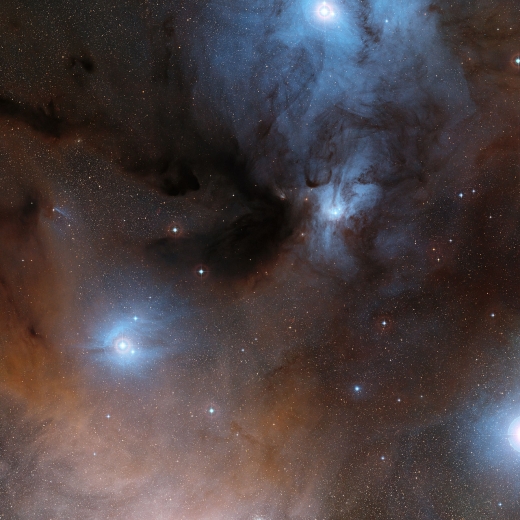
Image: The Rho Ophiuchi star formation region in the constellation of Ophiuchus. Credit: ESO.
Thus we continue to home in on the possibility that part of life’s story begins in space, with basic prebiotic chemistry occurring there and transferring prebiotic molecules to star systems in formation and, eventually, the planets that emerge. As a case in point, we find complex organic molecules of the kind commonly detected in interstellar space in comets in our own system (Rosetta found evidence for such on the surface of comet 67P/Churyumov-Gerasimenko). Methyl isocyanate has itself been detected before (in the molecular cloud Sagittarius B2), but never, until now, in protostars of solar mass.
The papers are Doménech et al., “First Detection of Methyl Isocyanate (CH3NCO) in a solar-type Protostar,” accepted at Monthly Notices of the Royal Astronomical Society (preprint) and Ligterink et al., “The ALMA-PILS survey: Detection of CH3NCO toward the low-mass protostar IRAS 16293-2422 and laboratory constraints on its formation,” also accepted at MNRAS (preprint).

